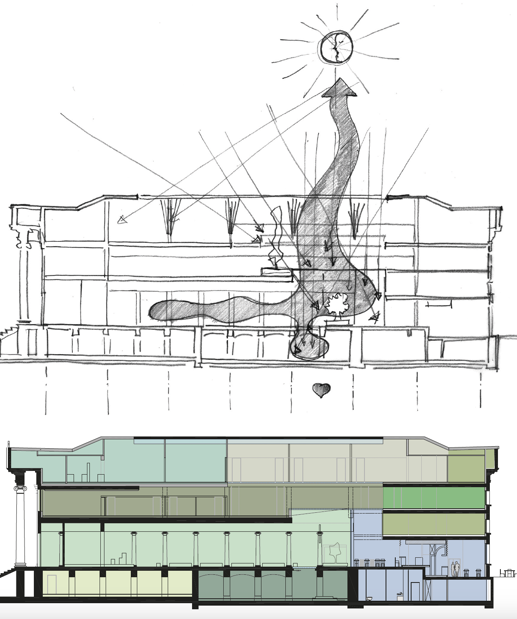Maison d'Eglise - Geneva
“The summer of 2018 will remain like a deep wound: the fire, the church badly damaged, the stupor of the parishioners, the people of Quartier and the city. But can this catastrophe, however dramatic, give us the opportunity to design the Sacred Heart of the future with a new refunding spirit?”
This is the question asked by Philippe, President of the Parish Council of the Church of the Sacred Heart, loca- ted in Planpalais, in the centre of Geneva. On July 19, 2018, the flames des-troyed the roof of the sacred building, the water to tame them damaged the plasters and the plants.
The building became unfit. Everything seemed lost. The fire had compromised much of the use of the building, forcing them to stop all activities. The doors were closed. Time seemed to have run out. As we scrolled through the pages of history, that colossal building was not born according to the principles of the Holy Roman Church.
It was built, starting from 1858, as a Masonic temple to remember, in its lines, with the imposing colonnade, those of Ancient Greece. Then, in 1873, the Parish of the Sacred Heart found its home, and in 1939 the building was adapted to the needs of Catholic worship. In 2018, the fatal burning seemed, however, to have seen the bell ring for the last time.
Instead, Philippe and his community said yes. Yes, you can start over, renew, crea-te a project for generations future.
They will invest huge resources to transform the temple. It will still be a church, but it will be above all the home of the Church, the place where the community gathers and lives.

The innovative choice
Atelier ribo+ is the designer of the rebirth intervention of the Sacred Heart Church in Maison d’Eglise. A project that stems from a mandate obtained thanks to the atelier’s ability to intervene on historical assets, matured over the years, and its constant ethical approach with the territories.
At the heart of the church renewal project are, in fact, values. Those defined by the Second Vatican Council, those that call for an active participation of the faithful in the liturgy. The altar will be in the centre and the pews around it, people will look each other in the face, they will feel part of a community.
The church will be used by the French-speaking and Spanish-speaking parishes. The offices of the Roman Catholic Church in Geneva will also be located there. Then the religious aspect will join the social and cultural one.
The choice is to rethink the church as a sacred place of the 21st century community, a reference point for the faithful, but also a socio-cultural engine within the urban context.
Greater accessibility through the horizontal axis opens up the building, in all its new functions, as a physical and spiritual ‘bridge’. At the centre of the building, this axis intersects and dialogues with the vertical axis sky-ground-sky.

Conclusion
The fire destroyed the church of the Sacred Heart in 2018, but there is a fire bigger than that of the flames, it is the one that burns in the parish community.
It is the Spirit that soul, it is the warmth of humanity that permeates it. It is that momentum that sees in the catastrophe the opportunity to think the unexpected, to realize a vision, a promise, a dream.
And the dream is to see the church not only as a place of prayer, but to create a home around it, to make it a meeting place for the community in every moment of social and cultural exchange. It is the desire for a church always alive .

